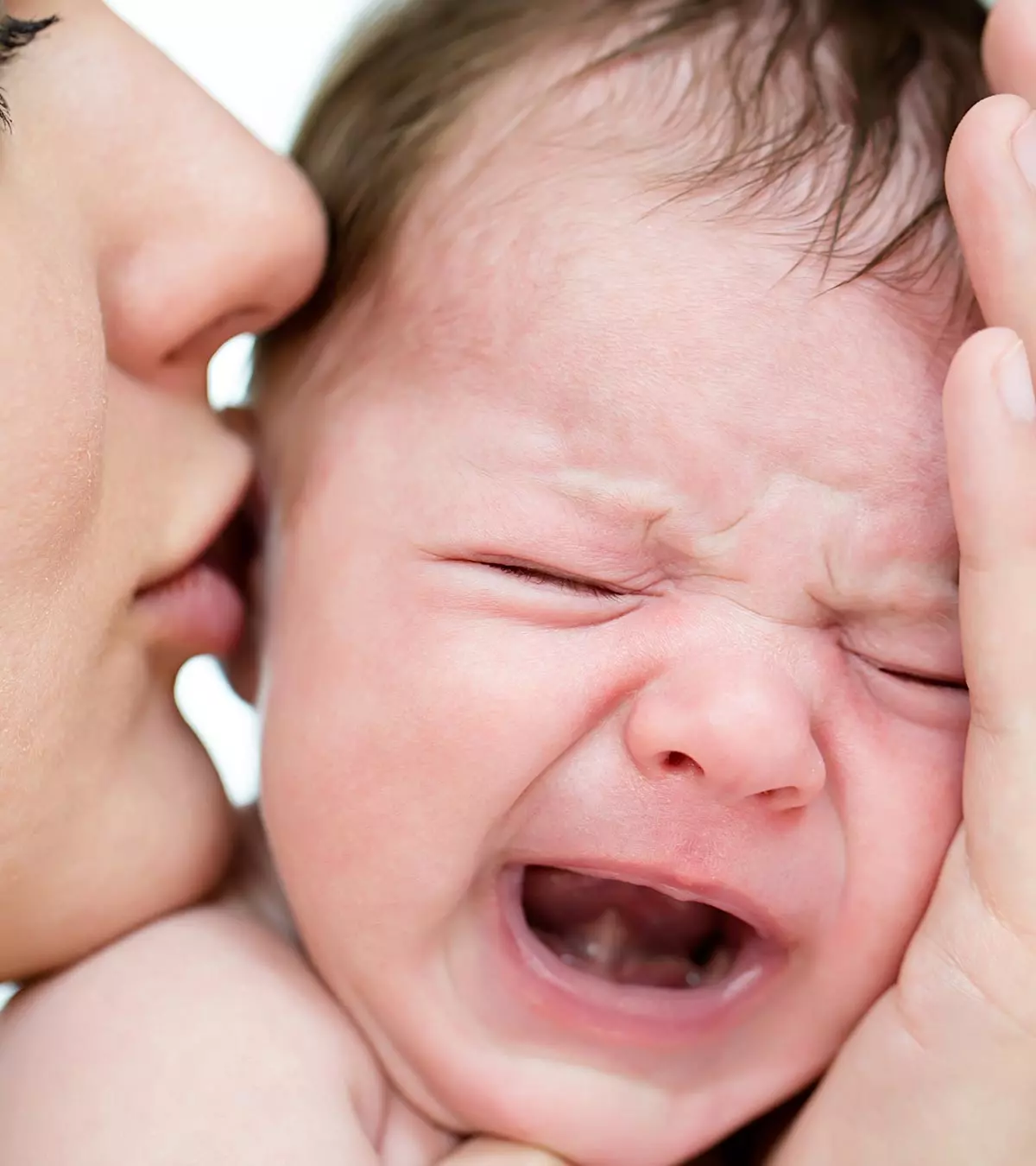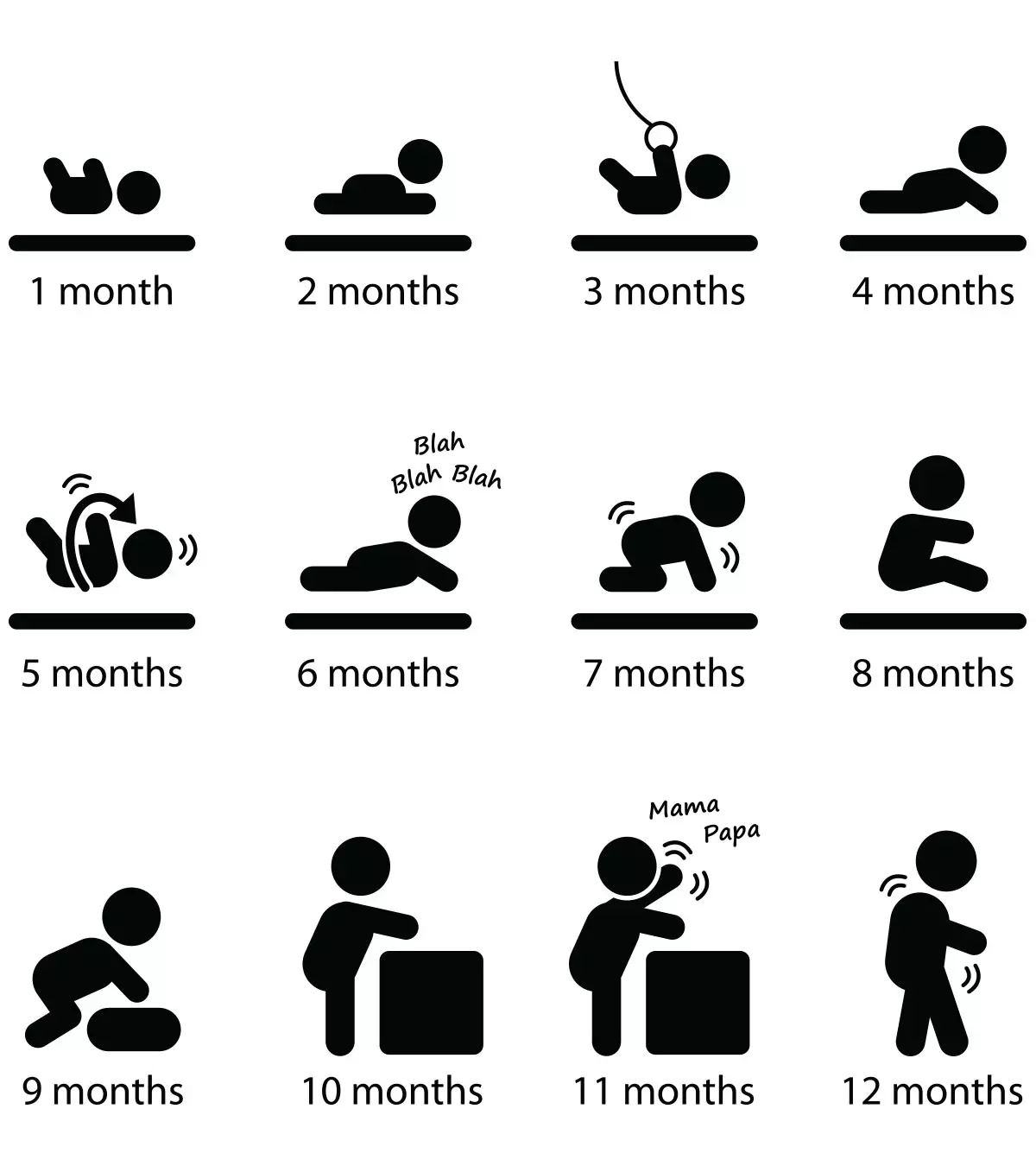
Image: ShutterStock
A baby boy growth chart can give you measurements of the growth standards of baby boys. A baby boy’s growth in the first weeks and months is rapid and follows a predictable pattern. In the first few days after birth, newborns may lose up to 10% of their birth weight but typically regain it within two weeks (1). By six months, most babies double their birth weight, and by one year, they usually triple it (2). Their length also increases significantly, growing about 10 inches (25 cm) in the first year (3). Tracking your baby’s growth helps you monitor their development in relation to their peers. Each baby achieves growth and development at a different pace, and slight delays are not a cause for concern. Growth charts help you know if their development is within the average for their age. Read on to know more about a baby boy growth chart, how to understand a growth chart and what parameters are compared in an infant growth chart.

Key Pointers
- Boys and girls have different growth charts due to growth rate and pattern variances.
- A baby boy growth chart is used to track development and growth compared to peers.
- The chart measures height, motor, and weight milestones like crawling, and sitting up.
- A baby boy’s development rate is determined by food, general health, genetics, and environment.
- Low birth weight newborns are more prone to mental health issues later in life.
How Is Baby Boy Growth Measured?
When we talk about baby boy growth chart, we usually gauge it in the following broad categories (4):
- Height
- Weight
- Other motor milestones such as sitting up independently, crawling, and walking with assistance.
Initially, doctors are more concerned about the baby’s height and weight. While a baby’s height depends largely on his genes, it is very important to keep track of baby weight charts. Weight can tell whether a baby is able to digest food properly and is able to extract nutrition from it.
Child Growth Percentile Calculator
Baby Growth Chart
A growth chart is essential to track your baby’s progress in accordance with his age. Though there is no ideal height and weight, there is a particular growth pattern that helps you assess your baby’s milestones.
 Research finds
Research findsBoys and girls have different growth charts because both have different growth rates and patterns (3).
Monitoring your baby boy’s growth during infancy and toddlerhood can provide valuable insights that will help you continue to support your child’s physical and emotional well-being throughout their adolescence.
Baby Boy’s Growth Chart
Growth percentiles help evaluate whether a baby is growing at a healthy rate compared to peers. A percentile refers to a child’s measurements relative to a group of children of the same age and gender. The below chart provides you with the measurement that ranges between the 3rd and 97th percentile of the World Health Organization (WHO) growth standards for baby boys (6). If your baby boy falls within the right range, then it is said that your boy has the right height, weight, and head circumference at his age.
| Months | Length (cm) 3rd to 97th percentile | Weight (kg) 3rd to 97th percentile | Head circumference (cm) 3rd to 97th percentile |
|---|---|---|---|
| 0 | 46.3 – 53.4 | 2.5 – 4.3 | 32.1 – 36.9 |
| 1 | 51.1 – 58.4 | 3.4 – 5.7 | 35.1 – 39.5 |
| 2 | 54.7 – 62.2 | 4.4 – 7.0 | 36.9 – 41.3 |
| 3 | 57.6 – 65.3 | 5.1 – 7.9 | 38.3 – 42.7 |
| 4 | 60.0 – 67.8 | 5.6 – 8.6 | 39.4 – 43.9 |
| 5 | 61.9 – 69.9 | 6.1 – 9.2 | 40.3 – 44.8 |
| 6 | 63.6 – 71.6 | 6.4 – 9.7 | 41.0 – 45.6 |
| 7 | 65.1 – 73.2 | 6.7 – 10.2 | 41.7 – 46.3 |
| 8 | 66.5 – 74.7 | 7.0 – 10.5 | 42.2 – 46.9 |
| 9 | 67.7 – 76.2 | 7.2 – 10.9 | 42.6 – 47.4 |
| 10 | 69.0 – 77.6 | 7.5 – 11.2 | 43.0 – 47.8 |
| 11 | 70.2 – 78.9 | 7.4 – 11.5 | 43.4 – 48.2 |
| 12 | 71.3 – 80.2 | 7.8 – 11.8 | 43.6 – 48.5 |
Source: WHO growth standards
The best way to keep track of your baby boy’s height and weight is to take him for regular doctor checkups. Your child’s doctor will measure his height, weight, and head circumference and will then compare them with the standard growth charts. You should use the below WHO charts to know his growth curve and percentile.
 Do remember
Do rememberWeight for age
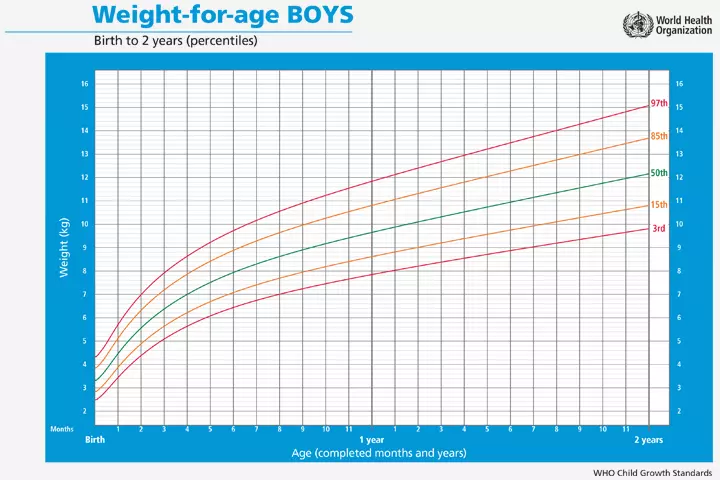
Length for age
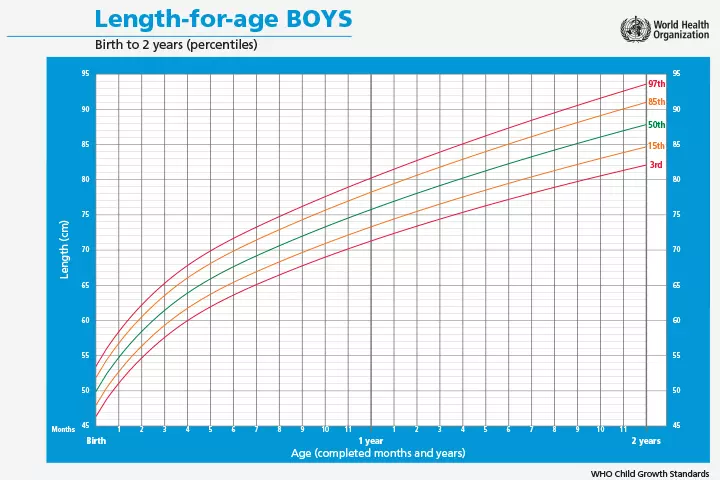
Weight for length
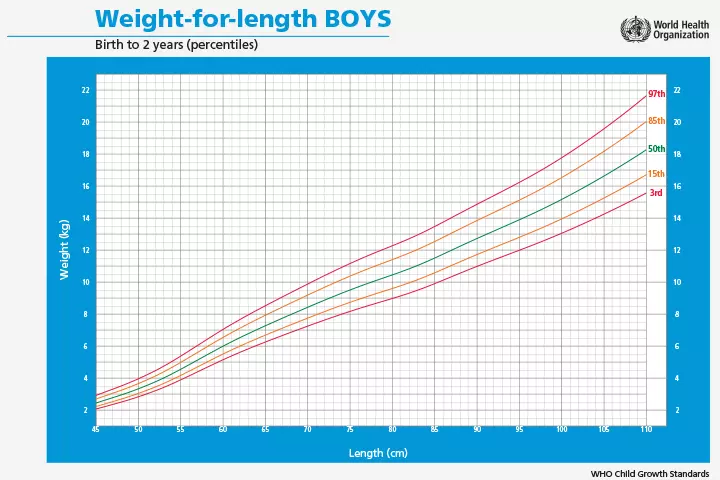
How To Read A Baby Growth Chart
Growth charts consist of curved lines representing percentiles (e.g., 3rd, 10th, 50th, 90th), which show how a baby’s growth compares to others of the same age and sex. To plot your baby’s growth, first, locate their age on the X-axis (bottom of the chart) and their weight, height, or head circumference on the Y-axis (side of the chart). Find the intersection point of these values and mark a dot. The closest percentile curve to this dot indicates where your baby falls in comparison to others.
According to the WHO, a baby growth chart is measured and read in percentiles. If a baby’s weight is in the 50th percentile, they are of average weight for babies of their age, i.e., 50% of the babies weigh more and the rest 50% weigh less. Similarly, if a baby’s weight is in the 90th percentile, they weigh more than 90% of the babies their age (8).
What Are The Different Types Of Growth Charts?
There are generally two types of growth charts; growth standards and growth references. Growth standards are prescriptive-based assessments of how children should grow with appropriate nutrition and health situations, whereas growth references are observations of children growing up in a specific community with the best possible nutrition and health status (9).
What Factors Can Influence Baby’s Growth?
Your baby boy’s growth rate depends partly on his body type and metabolism, and partly on his general health and wellness, feeding habits, and the environment.
The factors that have an influence include (10) (11):
1. Feeding: Feeding provides your baby with the necessary nutrients he usually requires to grow. Until he is six months of age, he is dependent on breast milk for nutrition. The amount and duration of feeding affect his growth (12). After six months, introducing solid foods rich in vitamins and minerals is crucial to support continued growth.
2. Your health when you are pregnant: This can influence the store of nutrients your baby possesses when born. Your diet, lifestyle habits and weight can also have a significant influence on your child’s growth in his first year.
3. Birth weight of your baby: It indicates how well you have nourished your baby during pregnancy. But, babies born with high birth weight grow slowly, and babies born with low birth weight grow faster. It is also known as ‘catch-down’ or ‘catch-up’ growth (12).
4. Prematurity: Preterm babies (born before 37 weeks of gestation) follow a growth pattern different from that of full-term infants. Many preterm infants experience catch-up growth. However, depending on how early they were born and any medical complications, some may take longer to catch up. A study report states, “ Children who were born at term-SGA continued to demonstrate deficits in weight and height during childhood whereas those born preterm showed catch-up growth by age 6–7y (13).” Specialized preterm growth charts, such as the Fenton Growth Chart, are used to track their growth more accurately (14).
5 Hereditary: Genes also play a significant role in a baby’s growth (15). If both parents are well-built and tall, your child is likely to be in a high percentile for height and weight. Likewise, if both parents are lean and short, even the baby might be lighter and of a short stature. For example, people from different cultures have different heights. Men from Europe and Central Asia are taller than men in South Asia (16).
6. Minor ailments: Illnesses like flu, constipation, and ear infections have an effect on a baby’s growth, but only temporarily (17). He may not feel like drinking milk when he is ill, and this may affect his growth for a week or more. The growth returns to normal once he starts getting better.

7. Your health after pregnancy: If you suffer from postnatal depression or are unwell for any reason, it will be difficult for you to take care of your baby. This may ultimately affect his growth. However, it is not permanent and gets resolved once you recover.
When Should You Consult A Doctor?
Sometimes you may worry about the growth and development patterns of your children.
- Some children who are short initially might grow a lot in the later stage
- Some who grow rapidly, in the beginning, might slow down when they grow up.
Seek medical attention under the following circumstances:
- If the baby’s weight or height percentile drops suddenly (e.g., from the 50th to the 10th percentile).
- If the baby’s weight gain is too slow (failure to thrive).
- If the head circumference grows too fast or too slow, which may indicate an underlying issue.
Frequently Asked Questions
1. What happens if my baby’s growth pattern changes?
If your baby’s growth pattern seems to deviate drastically from the growth chart, it may indicate an underlying problem, such as a growth issue. Your pediatrician will help diagnose and provide appropriate treatment if needed (18).
2. How to measure a baby boy’s height accurately?
A baby’s height can be measured using a horizontal length scale (HLS), tape measure, or an infantometer. Before measuring your baby’s height, remove all their clothing and accessories. Lay them flat on the surface in a supine position with their head touching the headboard, and position them so that the soles of their feet touch the footboard. Measure their length using any tools to the nearest millimeter (19). However, for accurate height and weight measurements, ensure that a professional does it to get reliable results.
3. How can parents ensure their baby boy gets enough physical activity?
Physical development in infants is fundamental for their overall growth and learning. Hence, parents should ensure that their baby engages in enough physical activity to support growth and development. Involve them in activities such as age-appropriate games and outdoor walking to make their playtime activities exciting and enjoyable.
4. What are the specific nutritional requirements for a baby boy’s growth and development?
Babies require foods from all the healthy food sources such as vegetables, dairy, grain foods, protein, and fruit. Avoid salty, sugary, and oily foods and drinks (20).
The baby boy growth chart can help you check if your boy is thriving according to his age. While it’s not a good idea to rely simply on chart numbers to determine your child’s growth, because growth is influenced by a variety of factors that are unique to each baby, it’s also not a good idea to ignore any significant delays or deviations. If you notice any glaring difference in your child’s growth pattern, you may consult your child’s doctor to seek timely treatment and guidance.
Infographic: What Influences A Baby’s Growth And Development?
Babies gradually attain height and weight appropriate for their age. However, if your baby fails to reach their average growth rate, there can be various factors responsible. Check out the infographic below to learn about the factors influencing your baby’s growth.
Some thing wrong with infographic shortcode. please verify shortcode syntaxIllustration: Baby Boy Growth Chart: Measurements To Track Height & Weight

Image: Stable Diffusion/MomJunction Design Team
Stay informed and at ease with an enlightening video about growth charts and babies. Gain crucial insights to alleviate concerns and enrich your rewarding and confident parenting journey. Happy Parenting!
References
- Your baby’s growth and development – 1 month old.
https://www.pregnancybirthbaby.org.au/babys-growth-and-development-1-month-old - Slow Weight Gain in Infants and Children.
https://www.childrenshospital.org/conditions/slow-weight-gain-infants-and-children#:~:text=Typically%2C%20a%20baby’s%20weight%20doubles,is%20not%20always%20a%20concern. - Your Child’s Growth.
https://kidshealth.org/en/parents/childs-growth.html#:~:text=What’s%20Normal%3F,fast%20after%20the%20first%20year. - Child growth standards.
https://www.who.int/tools/child-growth-standards - Low Birth Weight Babies At Higher Risk For Mental Health Problems Later In Life.
https://www.apa.org/news/press/releases/2017/02/low-birth-weight - Length-for-age BOYS.
https://cdn.who.int/media/docs/default-source/child-growth/child-growth-standards/indicators/length-height-for-age/cht-lfa-boys-p-0-2.pdf?sfvrsn=a6488b92_10 - What is low birthweight?
https://www.chop.edu/conditions-diseases/low-birthweight - Understanding baby growth charts.
https://www.pregnancybirthbaby.org.au/understanding-baby-growth-charts - Vaman Khadilkar and Anuradha Khadilkar; (2025); Growth charts: A diagnostic tool.
https://pmc.ncbi.nlm.nih.gov/articles/PMC3183514/ - Predicting a child’s adult height.
https://www.healthychildren.org/English/health-issues/conditions/Glands-Growth-Disorders/Pages/Predicting-a-Childs-Adult-Height.aspx - Your Newborn’s Growth.
https://kidshealth.org/en/parents/grownewborn.html - Breastfeeding is best.
https://www.marchofdimes.org/find-support/topics/parenthood/breastfeeding-best - Phuong Thi Nguyen et.al; (2025); Growth patterns of preterm and small for gestational age children during the first 10 years of life.
https://www.frontiersin.org/journals/nutrition/articles/10.3389/fnut.2025.1348225/full - Growth Charts for Premature Babies: Following Their Own Curve.
https://www.nationwidechildrens.org/family-resources-education/700childrens/2025/01/growth-charts-for-premature-babies - Lise Dubois et.al; (2012); Genetic and Environmental Contributions to Weight, Height, and BMI from Birth to 19 Years of Age: An International Study of Over 12,000 Twin Pairs.
https://journals.plos.org/plosone/article?id=10.1371/journal.pone.0030153 - Human Height.
https://ourworldindata.org/human-height - Your Child’s Appetite Has Changed: When to Worry.
https://www.rileychildrens.org/connections/your-childs-appetite-has-changed-when-to-worry - Child development guide: Ages and Stages.
https://choc.org/primary-care/ages-stages/ - Height Assessment.
https://www.ncbi.nlm.nih.gov/books/NBK551524/ - Healthy food groups for babies and toddlers: the five food groups.
https://raisingchildren.net.au/toddlers/nutrition-fitness/daily-food-guides/babies-toddlers-food-groups
Community Experiences
Join the conversation and become a part of our nurturing community! Share your stories, experiences, and insights to connect with fellow parents.
Read full bio of Dr. Orlena Kerek
Read full bio of Jessica Albert
Read full bio of Rebecca Malachi
Read full bio of Ghazia Shah














